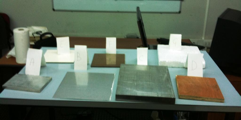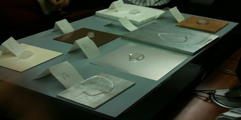| The Problem: |
| Activity 1.1 made evident that house models with wall of different materials warm up and cool down in different times. Moreover, by touching different materials in equilibrium with the environment it seems that they are at different temperatures since they supply different sensations of hot or cool. All these facts show different behaviours of materials in presence of a temperature gradient. This can be the starting point of the inquiry analyzing this kinds of behaviours. As a first step, the melting time of equal ice cubes, at the same temperature and placed in different plates, will be analysed. |
| Learning aims: |
|
• To be aware that the nature of material influences transfer of thermal energy between bodies at different temperatures. • To be able to classify materials according to their capability to conduct heat. • To identify variables that influence the heat conduction. |
| Materials: |
|
• Squares of different dimensions (surfaces and thickness) and different materials. • A set of ice cubes of almost the same dimension and at the same temperature (taken from the same refrigerator). |
| Suggestions for use: |
| The teacher can show the apparatus (see fig. 2.1a) and stimulate students to make predictions about the melting times NOTE. It could be useful, at this stage, to discuss about the feeling of warmness and coldness coming from touching different bodies, and also ask students about their bodies’ temperature.At this stage, it is also interesting to discuss about the concept of thermal equilibrium. |
|
Figure2_1a) Figure2_1b) |
| After the observation the whole class will discuss the results, by confronting them with their own predictions and making hypotheses about the influence of different parameters on melting times Teachers will introduce the concept of thermal conduction by discussing with pupils how to analyse the different parameters influencing the results (see fig. 2_1b). |
| Possible questions: |
| Questions referring to materials commonly used in everyday life and allowing a discussion about thermal insulation and thermal exchanges between environments at different temperature |

